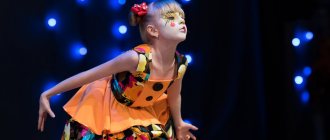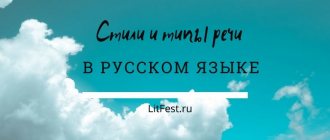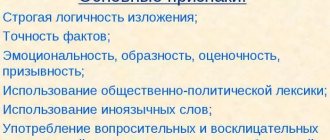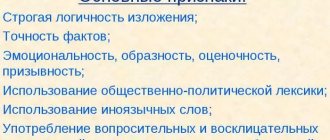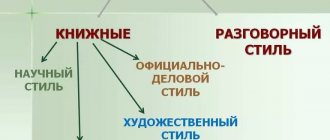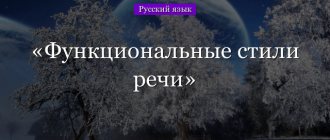In this article you will learn what an artistic style of speech is, what main functions it performs; distinctive features and characteristics of artistic style; what genres belong to this style of speech (with a description of each of them and examples).
In total, there are 5 functional styles of speech: scientific, official business, journalistic, artistic and colloquial.
The website has detailed information about each of the speech styles:
- Article “Characteristics, features and main genres of journalistic style of speech. Criteria for selecting news."
- Article "Features, features, genres and examples of scientific style of speech."
- Article "Distinctive features, signs, genres and examples of conversational style of speech."
- Article "Features, characteristic features, genres and examples of texts of official business style of speech."
Artistic style: concept, features
The author writes a story or novel in order to reveal his inner experiences to the reader.
Artistic style is used in literary works. Examples of literary text should tell about a life situation and reveal simple truths as understood by the author.
The artistic style is found in such genres as poem, verse, play, short story, novel and story.
In order to express emotions as fully as possible and more accurately explain a point of view, the author uses various linguistic means in an artistic style from other speech genres.
The aesthetic opinion of the narrator should cause not only a positive, but also a negative reaction in the audience. Without a response word, it is difficult to understand whether the reader has understood the lines read. This is one of the problems of a literary text. Not every author knows how to correctly use expressive means in the text.
Therefore, the reader may not delve into the author’s thought, may not be convinced of it, and may question what he has read. If after reading a person has questions or a desire to express an opinion, then this is considered a response to the work. But it does not guarantee a complete understanding of the meaning.
Having received answers to questions and listened to the opinions of other readers, he can be convinced of the accuracy and correctness of the narrator’s thoughts.
Examples of text analysis of different styles
return to the “Tables” page to the “Speech styles in the table” page, “Stylistic analysis”
ANALYSIS OF THE TEXT OF AN ARTISTIC STYLE
Song
(1) In the middle of the room stood Yashka the Turk, a thin and slender man of about twenty-three, dressed in a long-skirted blue nankeen caftan. (2) His sunken cheeks, large, restless gray eyes, a straight nose with thin, mobile nostrils, a white sloping forehead with light brown curls thrown back, large but beautiful, expressive lips - his whole face revealed an impressionable and passionate man. (3) He was in great excitement: he blinked his eyes, breathed nervously, his hands trembled as if in a fever... (4) Yakov paused, looked around and covered himself with his hand. (5) He took a deep breath and sang... (6) The first sound of his voice was weak and uneven and, it seemed, did not come out of his chest, but came from somewhere far away, as if it had accidentally flown into the room. (7) This sound was followed by another, more solid and drawn-out, but still apparently trembling like a string; followed by the second, the third, and, gradually warming up and expanding, a sad song began to pour out. (8) I admit, I have rarely heard such a voice: there was genuine deep passion, and youth, and strength, and sweetness, and some kind of captivatingly carefree, sad sorrow. (9) The Russian, truthful, hot soul breathed and sounded in him, and just grabbed you by the heart, grabbed you right by its Russian strings. (10) He sang, and from every sound of his voice you smelled something familiar and vastly wide, as if the familiar steppe was opening up before you, going into an endless distance. (I.S. Turgenev)
BEGINNING : The works of I. S. Turgenev depict the mystery of the human soul; the soul of a peasant who, despite the harsh serfdom, retained generosity, openness, and love of freedom. The depth of the soul, genuineness, sincerity, and desire for will are also revealed in Russian folk songs.
The main theme of this text, indicated in the title, is song. She is subordinated to 6 microthemes : 1) singer Yashka the Turk; 2) the singer’s facial features; 3) first sound; 4) the song flowed; 5) deep passion and hot soul in Yashka’s song; 6) in the song - infinity.
The author raises the problem of aesthetics. He is concerned about the expression of the soul of the people through art - music. The hero of the text, a native of the people, skillfully reveals the life of the Russian people like no other. The musical, impressionable Yashka the Turk is sensitive to the performance of the song - his whole soul is in it, so in his voice the narrator hears “genuine deep passion”, and youth, and strength, and sweetness... and sorrow.” Turgenev leads us to the idea that talent lives among the people, despite serfdom, and nothing can kill the love of freedom and space.
The text proposed for analysis, taken from a work of art , is a description of the subject . Why do we think so? The author, depicting the hero, pays attention to age, clothing, facial features, determines the nature of sounds, voices, songs. The writer also notes Yashka’s state of mind (“he was in great excitement: he blinked his eyes...”).
Fragments of the text are a narrative , which talks about actions that replace each other (“paused – looked – closed – sighed – sang”).
The sentences in the text are connected by a chain link , here there is a replacement of a noun with a personal pronoun (the sound is behind this sound). Admiring what he saw and heard, Turgenev creates a figurative, emotional picture, which is achieved by using various linguistic means: metaphor (“the song began to pour out, heated and expanding”), simile (“as if in a fever,” “as if he accidentally flew into the room”), epithet ( “expressive lips”), gradations (“sad grief”, “immensely wide”).
Ivan Sergeevich, describing the performer of the song, expresses his attitude towards him, calls him “an impressionable and passionate person” - these character traits help the singer convey the mood of the song, its depth. The author compares Yashka’s song with an endless distance, as if it absorbs the vastness of the fields and steppes of the Russian land, conveying the sound of the strings of the soul of a Russian person. The song comes from afar, the “Russian, truthful, ardent soul” sounds in it, and this song, connecting the past and present of the people, goes into the distance, into the future.
Thus , a folk song is truly a reflection of the life of the people. It contains his pain, and joy, and love, and suffering, and hope. In it lies his strength and immortality.
ANALYSIS OF TEXTS OF JOURNALISTIC STYLE
(1) “Everything, O Lucilius, is not ours, but someone else’s, only time is our property. (2) Nature has placed in our possession only this ever-flowing and impermanent thing, which, in addition, can be taken away from us by anyone who wants it... (3) People absolutely do not value other people’s time at all, although it is the only thing that cannot be return it back if you wish.” (4) This is what Seneca wrote at the very beginning of our era, in 50 A.D. (5) The ancient philosophers were the first to understand the value of time - they probably even before Seneca tried to somehow curb time, tame it, understand its nature, for then it was depressing with its transience. (6) However, due to our conceit, we are sure that the ancients had nowhere to go. (7) That they, with their sun, water and hourglasses, did not know how to measure it properly, and therefore did not take care of it. (8) Progress - after all, it comes down to this, in the opinion of a business person, to save this business person time. (9) To do this, the business man moved from the carriage to the train, and from there to the plane. (10) Instead of letters, they came up with telegrams and telephones, instead of theaters - televisions, instead of a quill pen - a ballpoint pen. (11) Escalators, computers, department stores, teletypes, electric shavers - everything is invented in order to save a person’s time. (12) However, for some reason, a person’s lack of this time is increasing. (13) A business person increases speed, introduces computers, converts department stores into department stores, prints newspapers using the photo method, and time pressure increases. (14) Not only for him - time pressure becomes universal. (15) There is not enough time for friends, there is no time for children to think, to stand without thinking in the autumn forest, listening to the crunch of flying leaves. (16) Neither schoolchildren, nor students, nor the elderly have time. (17) Time disappears somewhere, it becomes less and less. (D. Granin)
BEGINNING: Do we always value other people’s, and our own, time? And why should you save time? What do we do to save it? We will think about these questions together with the author of the text, D. Granin. ( Another option: How did the ancients relate to time? How did people try to curb time? Did modern man solve the problem of time pressure? This is discussed in the text by D. Granin).
The leading theme of this text is thinking about the lack of time. Three micro-themes are subordinate to it : 1) Seneca on time; 2) an attempt by the ancients to curb time; 3) the desire to solve the problem of lack of time. D. Granin is concerned about the issue of time shortage. He argues that you need to value time, your own and other people’s, because it “cannot be returned back.” The author leads us to the idea that with the enormous busyness of modern man, the inability to organize time can deprive him of the opportunity to come into contact with the world of beauty and enrich his inner world.
The analyzed text belongs to the journalistic style . What does this say? The text draws attention to the socially significant problem of lack of time. It is characterized by logic, imagery, emotionality, and evaluativeness.
Type of text - reasoning . Why do I think this? 1) The thesis is contained in sentence 3: “Time is the only thing that cannot be returned back no matter how hard you want.” 2) as proof . 3) The conclusion is contained in sentences 14-17.
The sentences in the text are connected by chain and parallel connections . What does this indicate? Thus, sentences 6-7 are connected by replacing the noun “among the ancients” with the pronoun “they”; the pronoun “for this purpose” in sentence 9 replaces part of the statement in sentence 7: “to save this business person time”; sentences 13 and 14 – by replacing the phrase “lack of time” with the word “ceyton” and the noun “business person” with the pronoun “he”. Sentences 15-17 are related in meaning.
The text proposed for analysis contains linguistic means characteristic of the journalistic style . What role do they play? Quoting helps D. Granin convince the reader of the significance of the issue raised; introductory words (“and therefore,” “in the opinion of a business person”) express the speaker’s attitude to what is being expressed; for the sake of homogeneous members (“to curb, tame, understand,” “increases, introduces, remodels”) create expressive semantic correlation; gradation (“neither among schoolchildren, nor among students, nor among old people”) “strengthens” the impression.
Thus , indeed, time pressure in our time is becoming universal. The lack of time is especially noticeable in a big city. People have no time to admire the beauty of nature, go to a museum, theater, chat with friends, or read an interesting book. A person turns into a robot and forgets about spiritual development.
ANALYSIS OF TEXT OF POPULAR SCIENTIFIC STYLE
(1) The mystery of blood circulation was revealed only in the century after numerous experiments on animals and the study of anatomy on human corpses. (2) It turned out that blood is not consumed in the organs, but only passes into them from arteries to veins through the smallest vessels - capillaries - and returns to the heart. (3) Thus, the closed nature of its movement throughout the body was established. (4) If we talk about a person, then on average during his life the lungs make 720 million inhalations and exhalations, and the heart makes three billion beats. (5) What a motor! (6) It is difficult to even compare this biological machine with something created by people. (7) This is why it has proven difficult to create an artificial heart. (8) Unfortunately, this task is very important, since the human heart often fails without exhausting the resources allotted to it by nature. (9) Now we are not talking about the problem of heart transplantation from a doctor. (10) We are talking only about artificial devices. (11) There has been some success here; many patients live with artificial heart valves. (12) But these operations are still very expensive, and there is also the problem of rejection of substances foreign to our body. (13) Research in this area is going on very intensively; there is enough work here for bionics (Children's Encyclopedia “I Explore the World”).
BEGINNING: How was the pattern of blood movement throughout the body established? Why not just create an artificial heart? What is the disadvantage of an artificial heart? This is stated in the text from the encyclopedia.
The leading theme of this text is a story about the work of the heart. Three micro-themes are subordinated to it : 1) discovery of the secrets of blood circulation; 2) the difficulty of creating an artificial heart; 3) “pros” and “cons” in the use of artificial heart valves.
This text raises the scientific problem of studying the work of the heart and the use of an artificial device.
The text belongs to the scientific style ; this is one of its substyles - popular science . Why do I think this? Here there are typical signs of a scientific style: logical presentation, accuracy, generalization, objectivity. Scientific judgments are written in accessible, clear, understandable language, explained in detail, and illustrated with examples.
The analyzed text belongs to the reasoning text . What does this say? It contains reflection on the issues raised in the text; there are sentences that are a kind of conclusion arising from the facts (sentence 3, 7).
Sentences in encyclopedia text are predominantly connected by chain links . What does this indicate? So sentences 1 and 2 are connected using the same root words “blood circulation” - “blood”; sentences 2 and 3 – by replacing the noun “blood” with the pronoun “her” and using the adverb “so” in sentence 3, replacing the statement in the previous one, the word “motor” in sentence 5 is a contextual synonym for the word “heart” in sentence 4.
The text contains language means characteristic of the scientific style, popular science substyle . What is their role? The use of terms (“blood circulation”, “arteries”, “vein”, “artificial heart”, “bionics”), phrases “noun. + noun in genus P." (“study of anatomy”, “problems of heart transplantation”, “problem of intrusion of substances”, abstract verbal nouns (“movements”, “transplants”, “searches”) emphasizes strict consistency, semantic accuracy, and reliability.
The use of exclamatory sentences , periphrases (“motor”, “biological machine”), introductory words (“unfortunately”), modal particles (“only”, “even”) simplifies the language of science, draws attention to the scientific problem raised and makes the text accessible for a wide range of readers.
Thus , this text attracts me with interesting facts from the field of medicine. It gives me pride in a person who has gone far in studying the work of the heart, and instills faith in me that in the distant future, human life expectancy will increase.
ANALYSIS OF SCIENTIFIC TEXT
On the issue of speech culture of foreigners
(1) The Russian language for foreign students is one of the linguistic disciplines, which equally involves both teaching the language, introducing into the student’s mind the idea of language as a system, and mastering the ethical side of the use of linguistic means in speech. (2) The teacher’s tasks, along with practicing the grammatical correctness of speech, include showing the appropriateness and ethics of using certain speech means and the specifics of their stylistic functioning. (3) The purpose of updating such knowledge and training on speech culture in a foreign audience is to create a comfortable communication environment for a foreign student, to satisfy the linguistic and other intellectual needs of the individual. (4) In this regard, taking into account the peculiarities of the mentality of students and the mentality of the Russian nation, preaching tolerance and goodwill in communication, at the advanced stage of training foreigners, special attention should be paid to the culture of speech as a syncretic discipline reflecting the linguistic, ethical, psychological, aesthetic aspects of communication.
(5) The sphere of communication of a foreigner is not limited only to professional interests. (6) In conditions of diversity of speech contacts, the achievement of a communicative goal in a specific situation is carried out thanks to the conscious (and sometimes unconscious) choice of speech means that, from the point of view of the speaker, optimize communication with native speakers. (7) A foreigner, who does not feel very confident in a foreign language environment, chooses short language formulas (often they are phonetically consonant with phrases of his native language), which would allow him to solve a communicative task: establish contact, have a positive attitude towards further communication, express a thought. (8) At the same time, sometimes a foreigner’s interlocutors – in particular, teachers – have to deal with violations of appropriateness and etiquette norms in his speech. (9) So, for example, to the question What is the ending in this case form? the Hindu student replied: Who knows! (10) It can be assumed that, in addition to the factor of not knowing the answer, this form of reaction was influenced by the brevity of the phrase and the desire to demonstrate “extended” language proficiency, not limited by the vocabulary of training sessions. (11) The Arabs, due to the significant graphic and phonetic differences of their language from Russian, also try to minimize speech means in both written and oral forms of transmitting information. (12) In particular, to establish contact during a meeting, they actively use the speech formula How are (your) doing? (13) In Russian-speaking audiences, this cliché is usually addressed from the teacher to the student, and not vice versa.
(14) So, we noticed that certain speech constructions are perceived by foreigners as ethically neutral, while in the Russian language they are characterized by peculiarities of stylistic functioning. (15) In this regard, due to insufficient cultural and speech competence in the conditions of a new language environment, the social characteristics of friend - stranger, younger - equal - elder, man - woman, often turn out to be irrelevant for foreigners. (16) Meanwhile, ethics is the most important component of communication, and teaching foreigners the culture of speech should be as mandatory as teaching the Russian language as a system.
(Larionova A. Yu. On the issue of the speech culture of foreigners // Linguocultural problems of tolerance: Abstracts of reports. International scientific conference (Ekaterinburg, October 24–26, 2001) Ekaterinburg: Ural State University Publishing House, 2001. With 243–244.)
- The text was created in a scientific style of speech ( academic substyle ).
- The genre of the text is the abstract of the report .
- Type of text - reasoning .
- The text refers to such a science as linguistics, to such a section as the culture of speech. The text is devoted to the problem of teaching foreigners the Russian language, namely, the need to teach them the norms of Russian speech etiquette.
- This text presents most of the stylistic features and linguistic features of the scientific style of speech.
5.1. The text is characterized by the accuracy of the presentation of information. This is achieved, firstly, through the use of special linguistic terms: language (1), linguistic means (1), speech (1), speech means (2), grammatical correctness (2), stylistic (2), speech culture ( 3), communicative goal (6), communicative task (7), language environment (7), lexicon (10), phonetic (11), written form, oral form (11), speech formula (12), cultural and speech competence (15); in addition, the words communication (3, 4, etc.), communication / communicative (5, 6, 16, etc.) are used, which can be considered interscientific (used in a number of humanities - linguistics, psychology, sociology).
Secondly, general scientific vocabulary is quite widely used: discipline (1), system (1), means (1), task (2), specificity (2), goal (3), sphere (3), stage (4), conditions (6), point of view (6), environment (7), formula (7), form (9), factor (10), design (14), feature (15).
Thirdly, the accuracy and coherence of the presentation of thoughts is achieved through the repetition of key words and phrases, which can be considered the following: teaching (language), speech culture, communication, communicative, linguistic (speech) means, ethical.
Fourthly, the accuracy and thoroughness of the presentation is facilitated by the presentation of factual data: to illustrate theoretical positions, the author uses examples of specific speech statements of foreign students (Who knows (9), How are you doing (12)).
5.2. The logical nature of the presentation is ensured by the active use of words and phrases that perform a connecting and formative function:
- to establish cause-and-effect relationships between phrases, the elements in connection with this (4), in virtue of (11), in this connection (15) are used;
- the function of comparing and contrasting parts of the text is performed by phrases both ... and (1, 11), the same as (16), along with (2), while (14), meanwhile (16);
— the meaning of the addition is formed using the element also (11);
— illustrations are introduced using words for example (9), in particular (12)
— the output value has the component so (14).
5.3. The text is fully characterized by the generality and abstractness of the information presented. At the language level, this is manifested, firstly, in the widespread use of nouns with abstract meaning; Wed words from paragraph 1: consciousness, system, correctness, appropriateness, ethics, specificity, peculiarity, tolerance, goodwill, mentality, etc.). In addition, the imperfective verbs used in the present tense form give a generalized, abstract character to the text; These are the vast majority of personal forms of the verb in the text: assumes (1), enters (2), is not limited (5), is carried out (6), chooses (7), tries (11), uses (12), is perceived (14 ), are characterized by (14), turn out to be (15). The exception here is the verb in the fragment of the text where the example is given (the Hindu student ... answered (9)); since in this case a specific individual situation is described, a departure from grammatical uniformity is justified and natural.
5.4. The text is characterized by restraint and severity of tone, unemotional presentation. The words used in the text have either a neutral (Russian language, foreign, teacher, comfortable, situation, contact, meeting, etc.) or a bookish (book-specific) stylistic connotation (student (1), syncretic (4), minimize (11), audience (13), competence (15), etc.). Reduced colloquial vocabulary, no jargon (exceptions are examples of student statements that are not components of the author’s text).
There are no emotional-evaluative lexical units in the text, however, words are used with which the author characterizes objects and phenomena, expressing a rational assessment: special (attention) (4), significant (differences) (11), actively (use) (12), insufficient (competence) (15), irrelevant (signs turn out to be) (15), most important (component of communication) (16).
There are practically no artistic means of expression in the text.
5.5. Despite the fact that in the text the author shares his own thoughts on the problem and presents the results of his own observations, the text, in accordance with the requirements of scientific stylistics, is characterized by a weak expression of the author’s personality . The construction [pronoun I + verb in personal form] is absent, but alternative grammatical structures are found:
— impersonal construction: should be given (special attention) (4);
- passive construction with the author's we: we noticed (14).
5.6. The text, in accordance with the characteristics of the academic substyle, is distinguished by grammatical complexity , which is manifested in a number of parameters.
Verbal nouns in -i/-nie and -iya/-tion are widely used (in terms of quantity in the text they significantly prevail over verbs): training (1), implementation (1), presentation (1), assimilation (1), use (1), use (2), functioning (2), presentation (3), knowledge (3), creation (3), communication (3), satisfaction (3), achievement (6), violation (8), ignorance (10), desire (10), reaction (10), possession (10), occupation (10), difference (11), establishment (12).
Participles and participial phrases are used quite actively: in discipline, reflecting the linguistic, ethical... aspects of communication (4); speech means that optimize... communication (6); a foreigner who does not feel very confident in a foreign language environment... (7); “extended” possession (10); language proficiency not limited to the vocabulary of classes (10);
There are adverbial phrases: taking into account the peculiarities of mentality... (4); preaching tolerance... (4).
There are verbs in the passive voice: the sphere... is not limited (5); achieving the goal... is carried out (6); designs are perceived (14).
A construction with a chain of words in the form of the genitive case is repeatedly used: assimilation of the ethical side (RP) of the use (RP) ... of linguistic means (RP) (1); showing the appropriateness (R.p.) and ethics (R.p.) of the use (R.p.) of certain speech means (R.p.) (2); creating for a foreign student (F.S.) a comfortable sphere of communication (R.S.) (3).
The complexity of the syntax is manifested in the fact that out of 16 sentences of the text, only four (5, 9, 12, 13) are short enough and do not have significant complicating structures. The remaining sentences are complicated by isolated definitions (for example, 4, 6, 7, 10), participial phrases (4), complementary, explanatory and clarifying constructions (for example, 2, 6, 7, 10, 11), chains of homogeneous members of the sentence (for example, 2, 3, 4, 7, 15) . Sentences 1, 7, 14 are complex.
Let's take a closer look at the sentences of one of the paragraphs, for example the first.
(1) The Russian language for foreign students is one of the linguistic disciplines, which equally involves both teaching the language, introducing into the student’s mind the idea of language as a system, and mastering the ethical side of the use of linguistic means in speech. – The sentence is long, complex, contains a couple of homogeneous members (both learning... and assimilation).
(2) The teacher’s tasks, along with practicing the grammatical correctness of speech, include showing the appropriateness and ethics of using certain speech means and the specifics of their stylistic functioning. – The sentence is complicated by a separate addition (along with practicing the grammatical correctness of speech) and a chain of homogeneous additions of 3 components (appropriateness and ethics... specificity).
(3) The purpose of updating such knowledge and training on speech culture in a foreign audience is to create a comfortable communication environment for a foreign student, to satisfy the linguistic and other intellectual needs of the individual. – The sentence is complicated by three pairs of homogeneous members of the sentence (knowledge, training; creation... satisfaction; linguistic and... intellectual).
(4) In this regard, taking into account the peculiarities of the mentality of students and the mentality of the Russian nation, preaching tolerance and goodwill in communication, at the advanced stage of training foreigners, special attention should be paid to the culture of speech as a syncretic discipline reflecting the linguistic, ethical, psychological, aesthetic aspects of communication. – The sentence is long, complicated by two homogeneous adverbial phrases (taking into account the peculiarities of the mentality of students and the mentality of the Russian nation, preaching tolerance and goodwill in communication); a separate definition with a chain of homogeneous members (reflecting the linguistic, ethical, psychological, aesthetic aspects of communication).
- Thus , most of the stylistic features and linguistic features (both lexical and grammatical) typical of the scientific style were found in this text. There are no facts in the text that would indicate a deviation from the stylistic norms of the language of science (colloquial, emotional and evaluative vocabulary, artistic means of expression, phraseological units, an abundance of short and uncomplicated sentences, etc.). Consequently, we can conclude that the speech work we analyzed fully complies with the stylistic requirements of a written scientific text created within the academic substyle.
ANALYSIS of the text of official business style
A household contract is concluded by placing an Order on a standard form established by the Contractor (ISNA LLC), one copy is issued to the Customer (citizen), and the second remains with the Contractor.
In accordance with the rules of consumer services for the population in the Russian Federation (approved by Decree of the Government of the Russian Federation of August 15, 1997 No. 1025), when drawing up an agreement for the performance of work on the manufacture of furniture, the Customer has the right to offer his drawing (sketch) of the product by filling out an addition to the Order or to use samples of furniture provided by the contractor. /Rules for performing furniture manufacturing work / Text analysis. This text refers to the official business style. Area of use: office work. Addressee – customer and contractor (organization that manufactures furniture). The purpose of the text is to inform citizens about the rules for making furniture. General properties of the text: prescriptive nature of the presentation, formality of tone, standardization of speech, accuracy (link to specific documents) Lexical features: -
use of clichés characteristic of a given style (these rules are established, a household contract, this agreement is a contract, is concluded by execution, etc.) d.) - the exact name of the institution, documents, abbreviations (ISNA LLC, Article 428 of the Civil Code of the Russian Federation, Government of the Russian Federation) - words are used in their direct meanings (agreement, form, contractor, customer, etc.)
Morphological features: -
predominance of nouns, including verbal ones (rules, contract, contract, execution, accession, service, etc.) - abundance of noun constructions.
+ noun R.p. (terms of the contract, when performing work, agreement of adhesion, etc.) -use of a denominate preposition ( by
formalization) -use of imperfect verbs (establish, is, is concluded, remains, etc.)
Syntactic features: -
simple, very common sentences (for example: “These rules establish the terms of the household contract (Article 730 of the Civil Code of the Russian Federation) when ISNA LLC performs work on the manufacture of furniture. This household contract is an adhesion agreement and is subject to the rules of Article 428 of the Civil Code of the Russian Federation") -complexity of syntax: isolation of different types. (“A domestic contract is concluded by placing an Order on a standard form established by the Contractor (ISNA LLC), one copy is issued to the Customer (citizen), and the second remains with the Contractor) - the text contains passive phrases (for example: “on the standard form forms established by the Contractor; approved by the Decree of the Government of the Russian Federation")
ANALYSIS OF CONVERSATIONAL STYLE TEXT
Hello, Sashka! I have amazing news! Just imagine, dad almost crashed his car yesterday. Do you remember that there was never a traffic light at the intersection near our house? Not even now. So, dad went to park the car in the garage through this stupid intersection. A number of them were allowed through. And suddenly some impudent foreign car drives out at speed from the right. He probably decided to avoid the traffic jam. Dad didn't expect this and didn't have time to stop. In general, everything ended well - they barely had time to turn around! Thank God, no one fell in love with anyone. Immediately, traffic cops appeared from somewhere and gave that crazy driver a fine. And he didn’t even apologize to dad – can you imagine?! Like this. Text analysis
.
This text is in a conversational style. Area of use: everyday communication. The addressee is a well-known person. The purpose of the text is to share information with the interlocutor. The text is characterized by emotionality and ease (it can be a phone call, or a conversation between friends). Lexical features:
- neutral vocabulary with a specific meaning predominates (news, yesterday, car, traffic light, intersection, garage, etc.) - there is colloquial, emotionally charged vocabulary that conveys the speaker’s attitude to what happened (dad, amazing, stupid, arrogant foreign car, traffic jam, barely, traffic cops, etc.)
Morphological features:
- evaluative adjectives and verbs (amazing, arrogant, abnormal, sniffed, etc.), - abundance of pronouns, interjections, particles (hello, for me, almost, our , thank God, even so)
Syntactic features:
- simplification of syntax (usually simple sentences, absence of participial and participial phrases), incomplete sentences (often as part of a complex sentence) For example: I have amazing news. Not even now. Dad didn’t expect this and didn’t have time to stop, etc. - one-part sentences: Can you imagine? Do you remember? A number of them were allowed through. - introductory words (probably) - there is an appeal to the interlocutor, talking about friendly relations (Sashka)
If you have any questions, ask in the discussions https://vk.com/board41801109 If you have mastered the topic, share with your friends. Test on the topic Types of texts Test on the topic Meaning of the text Test on the topic Types of speech Test on the topic Stylistics Test on the topic Functional styles of speech Tests on the topic Scientific style of speech Tests on the topic Publicistic style Tests on the topic Official business style Test on the topic artistic style Test on the topic Conversational style return to the “Tables” page to the “Speech styles in the table” page, “Stylistic analysis”
Distinctive features of the artistic style
- The author expresses his own position through various tools of literary language. A sentence in an artistic style contains tropes - epithets, metaphors, direct speech, comparisons, etc.
- Lyrics in the genre of artistic style are filled with emotion.
- The characters of fiction are described vividly and vividly using linguistic means.
- The presence of the author in some works is constantly observed.
The main task of the artistic style is to convey to the reader the opinion of the author in such a way that this opinion will receive a response (criticism). Various styles of fiction allow you to present any information in an interesting and unusual way.
For example, scientific phenomena are described in works using a scientific and artistic style. An artistic and journalistic style can be used in newspapers and magazines.
Main functions
People created literary texts many centuries ago. Such works were special; they conveyed how the author sees reality. Over time, the techniques developed and improved, but the function of the style remained the same. It was intended to convey to the reader the author's vision of the world - real or fictional.
Initially, the word “style” (obsolete “stele”) meant a thin stick for writing or creating graphics. Subsequently, this became the name for a pencil. Thanks to style, the writer receives unlimited opportunities to express the subtlest shades of meaning, convey his thoughts and evoke a certain emotional state in the reader. Within this direction, the author enriches written speech with means of expressiveness. Social functions performed by style:
- Impacting. The work makes you empathize, be indignant, rejoice and experience other emotions.
- Communicative. The author of works of fiction, unlike a publicist, addresses not a faceless audience, but “his” reader, with whom he speaks the same language. A kind of dialogue ensues between the author and the person reading the book. The writer conveys his vision of the world and expects understanding.
- Informative. From literary texts, people receive a lot of information about the causes and consequences of phenomena and events, the laws of the development of the world, the moral laws by which relationships between people are built, and much more.
- Aesthetic. This function subordinates the others. The author reproduces reality in the text using a complex system of images (people, things, phenomena, etc.).
The purpose of style is to evoke certain emotions in the reader. They can be achieved if the work fulfills its functions. There are only three of them:
- Figurative-cognitive. Using the emotional component, the writer talks about something. The reader understands the world using the system of images proposed by the author.
- Ideological and aesthetic. The transmission of the main thoughts and ideas of the work is carried out through a colorful description of images.
- Communicative. It is about finding common ground between the fictional and real worlds. If the reader succeeds, then the author has coped with the task.
Main features of artistic style
To understand that a text is literary, you need to find certain signs. The features described above are characteristic of the artistic style. Other characteristics can be added to them.
- Speech multitasking. In a well-written literary style text, every word will have meaning. The words will provoke different thoughts in the reader regarding further events in the story.
- It is not always clear which language device the author used. The essence of the text is not to explain linguistic forms of self-expression, but to show point of view, feelings, thoughts.
- A storyteller can convey his or her position in many different ways. You can do this smoothly, or brightly and calmly. In any case, the text of the artistic style implies the self-expression of the author.
- Each storyteller has his own style. The author takes any means from another genre of the Russian language. For this reason, the works differ from each other. In other words, an “author’s style” is created.
- Organized text. The work has a clear chapter structure.
- One word can have several meanings.
- Template phrases are not used.
Features of artistic style
There are three distinct functions of artistic style.
- The first is aesthetic. A literary text not only conveys a certain meaning to the reader, but also evokes aesthetic feelings. Through ideological perception, the audience must understand the meaning of the entire work.
- The second function is influencing. Through emotions, the author influences the reader and at the same time conveys information about the world. The information can be simple worldly wisdom, the author’s opinion on any issue.
- And the third function is communication. The reader responds to the thoughts and ideas described in the work. If the text has completed the first two tasks incorrectly, then there will be no response from the audience. This means that the work did not fulfill a single task and the narrator’s worldview was misunderstood.
Text stylistics
Text stylistics examines the patterns of organization of linguistic units that are subordinate to a speech work - the text as an ideological, content, functional, compositional and structural unity; clarifies the methods and norms of organizing linguistic units in texts of a certain purpose and content; studies intra-paragraph connections and stylistics. characteristics of sentences, supra-phrase unities in their relationship with the paragraph, with the general composition and syntactic. structure of the text, correlation of compositions. parts of the text with a certain set of linguistic units depending on the ideological content and genre compositions. features of the text, its functional and stylistic affiliation.
Area of use of the style
The artistic genre is used in literature. Sub-styles are divided: artistic-journalistic and scientific-artistic.
Due to its syntactic and morphological characteristics, the style is used in such sub-styles as epic, lyric poetry, drama.
Epic is divided into epic, novel, short story and tale. Epics are also considered epics, ballads, legends, myths and parables.
- In the epic, historical events play a large role.
- The storyline of the novel is based on the lives of the characters.
- The story is about one incident.
- The story contains the characteristics of a short story and a novel.
- Lyrics, that is, poetic form, are divided into ode, epigram, elegy, sonnet. This genre is well used by Shakespeare.
- An ode is a praise of an event or a person, an epigram is a satirical poem.
- Elegy is a lyric poem.
- A sonnet is a special poetic form with a strict structure.
- Drama is divided into genres such as comedy, drama, and tragedy.
- In comedy, the author ridicules social problems or vices using satirical techniques.
- Tragedy tells about the broken destinies of heroes.
- Drama makes very good use of the medium of dialogue in an artistic style.
- Through dialogue, it describes a sharp and interesting plot, the relationships of the characters with each other and society.
Linguistic features of artistic style of speech
The artistic style uses various linguistic means. Some are borrowed from other genres. The main feature of the artistic style is the abundance of morphological and syntactic properties.
A large role is given to verbs, pronouns, adjectives and participles. They make the text dynamic and sincere. The text of the artistic style uses the entire wide range of syntax - punctuation marks, participial phrases, direct speech, quotations.
Authors of literary style texts use word formation methods. In particular, the suffixes of words are changed to add emotion. This can be seen when analyzing the text of an artistic style.
Application in other forms of art
The artistic style is used in various forms of art, including painting. However, artists do not use it in its pure form, but combine different directions. In addition, in the visual arts there is a tendency to constantly change styles: some flow into others, merge with others and acquire new features.
In the process of painting an oil painting or creating a graphic design, modern European and Asian artists do not limit themselves to traditional means. Often they stylize their works so strongly that they violate cultural norms. This is typical for fashion masters of the current era. Artistic directions in painting:
- baroque;
- classicism (classical);
- Revival;
- Gothic;
- purism;
- cubism;
- naturalism;
- abstract art (abstract);
- urbanism (urbanistic);
- impressionism;
- geometry (geometric).
Within each direction, researchers name prominent representatives. So, in impressionism it is Claude Monet, in cubism it is Pablo Picasso, in urbanism it is Edward Hopper, in naturalism it is José Julio de Souza Pinto.
When talking about style, researchers usually mean 2 meanings: global and narrow. In the first case, we are talking about a set of tools and techniques that involve repeatability. In a narrow sense, style is the individual handwriting of the master, which can be traced in every creation. The situation is similar in architecture, music, theater, cinema and other forms of art.
Detailing in literary text
Every detail is clarified in the text. Even if it does not affect the further plot. For example, in the novel The Thorn Birds, the story about the bird at first seems incomprehensible.
However, there is a hint of a conventional love story. Already at the end of the book, the full meaning of the priest’s quote is revealed to the reader. At first glance, this story about a bird singing once in its life means nothing. But after reading further, it will become clear what the author means.
Detail in a story can mean something important. This is a kind of hint or preparation of the reader for an important event or discovery.
Conveying the author's feelings and emotions
The author supplements his own opinion with feelings and emotions. This technique accomplishes the task of forming the audience’s attitude towards the described situation.
Epithets
An epithet (from the Greek ἐπίθετον - “attached”) is a trope expressed in the form of an adjective, less often an adverb, a noun, or a numeral.
When an epithet appears in the text, a different meaning, a new shade appears. A word “attached” to this element becomes colorful and rich. For example, “wooden face”.
The epithet complements the author’s opinion, makes it more detailed, describes the nature of the subject and creates the necessary atmosphere. There are tautological and folklore epithets.
Metaphors
Metaphor (ancient Greek μεταφορά - “transfer”, “figurative meaning”). From the ancient Greek language this word means “transfer”.
In the text, metaphor has the same meaning - that is, the properties of one object are transferred to another. The author compares phenomena using words, replacing meaning. The reader unravels the mystery almost immediately.
Example: “When Varya saw the price of the bag, she was “strangled by a toad.” Seeing the price, Varya regretted spending money on it. If the author had described what was happening in direct phrases, the sentence would hardly have had any mystery or interest.
Comparisons
Comparison is a common trope. Its meaning is to compare two objects or phenomena in relation to one phenomenon (or object). The purpose of this action is to discover new properties that are important for the narrator.
Allegory
Allegory is the author's explanation of abstract ideas using a subjective image. It can also be expressed in the form of dialogue. That is, the author explains a stereotype using a specific case.
Using elements from other styles
The main elements borrowed from other styles in a literary text are direct speech. In general, there are quite a lot of other stylistic elements in the artistic style. Direct speech is taken from the conversational style.
Inversion
In inversion, the significant part of the sentence stands out among other words. This also affects the further meaning of the entire plot. It stands out by rearranging the word.
Artistic style example analysis
Any literary text can be identified by its characteristics. Let's take an excerpt from Bunin's work:
Features inherent in a work of art:
- Details are described carefully.
- Lots of epithets.
- The text evokes emotions.
Related posts:
- Journalism - what kind of speech style? The journalistic style is often called modern chronicle, because it is entirely...
- Speech styles - a brief overview of all styles Different speech styles have their own functional characteristics. There are scientific, artistic,…
- Style of Scientific Writing - History and Prosperity How to Write a Scientific Paper? Prepare a report for a conference? And what…
- Conversational or everyday style of communication in Russian...
Examples of texts
This style can be found everywhere. It is present in poems, stories, novels, novellas. Every author has his favorite techniques. For example, some actively use detail, while others saturate the text with epithets. An example of a text with an artistic style of speech, emphasized by detail: “The soldier walked briskly along the white sand, warmed by the scorching rays of the sun. All his clothes were wet, and his skin showed red marks left by the barbed wire. An aching pain permeated his whole body, but he walked, gathering his last strength, because the headquarters was already visible in the distance.”
This passage shows the physical suffering of a soldier, and the author pays attention to details that allow the reader to understand what the character is going through. The second passage is an example of how epithets can be used: “The little mischief maker Yasha was not just a tomboy, but a child with great potential. One only has to remember how masterfully he cleaned out Baba Zina’s garden. As he grew up, he became just as skilled at stealing money from banks. The fraudster managed to act so cleverly that he was never caught in the act.”


